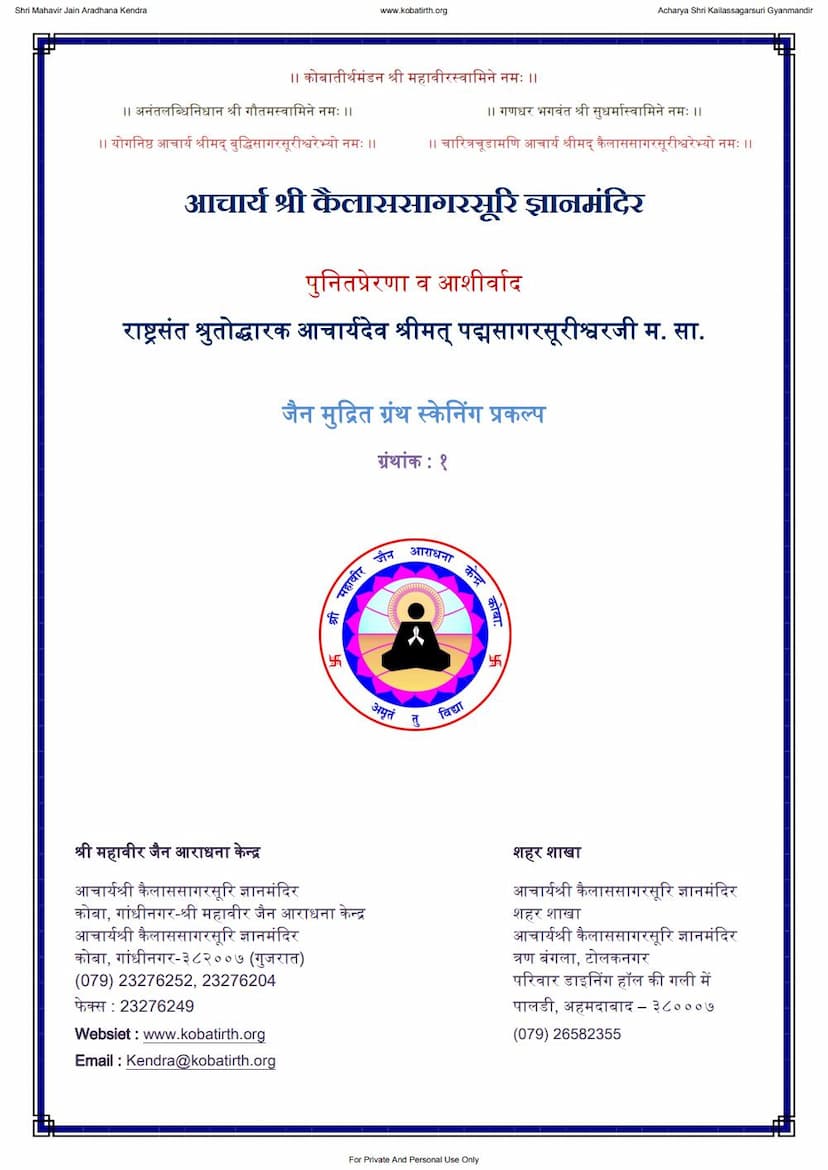Sankhya Darshanam
Added to library: September 2, 2025

Summary
This document is an excerpt from a Jain text titled "Sankhya Darshanam," authored by Shreekapil Maharshi and published by Jivanand Vidyasagar Bhattacharya. The provided text is the initial pages, including the title page, publisher information, copyright notices, and the beginning of the introduction and the first chapter of the commentary by Vigyanabhikshu.
Here's a comprehensive summary of the provided content:
1. Title and Author:
- Title: Sankhya Darshanam (साङ्ख्यदर्शनम्)
- Author: Maharshi Shri Kapil (महर्षि-श्री कपिल-प्रणीतम्)
2. Commentary:
- Commentator: Vigyanabhikshu (विज्ञानभिक्षु-विरचित-भाष्यसहितम्)
3. Publisher and Publication Details:
- Publisher: Shri Jivanand Vidyasagar Bhattacharya (श्रीजीवानन्दविद्यासागर भट्टाचार्येण)
- Publication: Published and Sanskritized by Shri Jivanand Vidyasagar Bhattacharya, holder of a B.A. degree.
- Publisher Address: Saraswati Sadan, Kolkata (Shri Kailashmarg, Kolkata). The publisher is identified as Shri Jivanand Vidyasagar B.A., wife of Shri Ramanath Majumdar, Kolkata.
- Printer: Shri Kshetramohan Mukhopadhyay, Kolkata.
- Edition: Second Edition (हितीयसंस्करणम्).
- Year: The publisher's address indicates publication in 1883, but the text itself does not explicitly state the year.
4. Jain Context and Copyright:
- The document is presented by "Shri Mahavir Jain Aradhana Kendra, Kobatirth" and "Acharya Shri Kailassagarsuri Gyanmandir."
- There are several dedications and salutations to Jain figures and Acharyas, including Shri Mahavir Swami, Shri Gautam Swami, Shri Sudharma Swami, Acharya Shrimad Buddhisagarsurishwarebhyo, and Acharya Shrimad Kailassagarsurishwarebhyo.
- The text is explicitly marked "For Private And Personal Use Only," indicating a restricted distribution for personal study.
- The "Jain Mudrit Granth Scanning Prakalp" (Jain Printed Book Scanning Project) is mentioned, with the book catalog number as 1.
5. Content of the Introduction (Bhumika - भूमिका): The introduction, attributed to Vigyanabhikshu, sets the stage for the Sankhya philosophy. Key points discussed include:
- The Goal: The ultimate goal is the attainment of liberation (Moksha), which is described as the complete cessation of the three types of suffering: Adhyatmika (mental and physical suffering originating within the body), Adhibhautika (suffering caused by other living beings), and Adhidaivika (suffering caused by natural forces like heat, cold, etc.).
- The Path: The text emphasizes the importance of seeking the Self (Atma) through listening (Shravana), contemplation (Manana), and meditation (Nididhyasana), as prescribed in the Upanishads.
- Sankhya's Uniqueness: It highlights the unique contribution of Sankhya Darshanam, as expounded by Kapil Muni, in providing a systematic philosophical framework (six chapters) for understanding the nature of reality and the path to liberation.
- Comparison with Other Philosophies: The introduction engages in a comparative analysis, contrasting Sankhya with other schools like Nyaya, Vaisheshika, Mimamsa, and Yoga.
- It argues that while Nyaya and Vaisheshika establish the soul's existence through a process of negation and distinction from the body, they only provide a preliminary understanding.
- It addresses potential conflicts, particularly regarding the existence of Ishvara (God). The text proposes that the concept of Ishvara can be understood in both practical (Vyavaharika) and ultimate (Paramarthika) contexts. It suggests that Sankhya's denial of Ishvara might be a practical approach to detach the mind from worldly conceptions of divinity, facilitating deeper introspection.
- It asserts that Sankhya's knowledge leads to supreme detachment and direct liberation, surpassing the indirect liberation achieved through other means.
- It defends Sankhya against accusations of contradiction with Vedanta and Yoga, proposing that the perceived differences are resolved through understanding the philosophical context and the intended scope of each doctrine.
- Sankhya's Framework: The text mentions that Sankhya deals with four "vyuhas" (divisions or aspects): Heeya (what is to be abandoned - suffering), Hāna (abandonment), Heyahetu (cause of suffering), and Hanopaya (means of abandonment).
- The Nature of Suffering: The first sutra (1) is quoted: "Athā trividhaduhkhātyantanivr̥ttiratyantapuruṣārthaḥ" (Now, the complete cessation of the three kinds of suffering is the ultimate human goal). The text elaborates on the nature of suffering, distinguishing between present, past, and future suffering, and identifying future suffering as the primary focus for liberation.
6. Structure of the Text (as indicated by the pages): The provided pages cover:
- Title pages and acknowledgments.
- A lengthy introduction (Bhumika) explaining the philosophy and its context.
- The beginning of the commentary on the first chapter (Prathamo Adhyayaḥ - प्रथमोऽध्यायः), starting with the explanation of the first sutra.
7. Philosophical Concepts Discussed:
- Trividha Dukha: The three types of suffering.
- Atma Vichara: The inquiry into the Self.
- Shravana, Manana, Nididhyasana: The methods of self-realization.
- Ishvara (God): Discussion on Ishvara's existence and its relevance in Sankhya.
- Bondage and Liberation (Bandha and Moksha): The causes of bondage and the means to liberation.
- Prakriti and Purusha: The fundamental principles of Sankhya (though not explicitly detailed in these introductory pages, their interaction is implied as the cause of suffering and the means to liberation).
- Causality: Discussion on the nature of causes and their relation to effects.
- Pramanas (Means of Knowledge): Mention of the validity of different means of knowledge.
- Vyavaharika vs. Paramarthika: The distinction between practical and ultimate reality.
In essence, the provided document is a scholarly presentation of the foundational principles of Sankhya philosophy, as interpreted and commented upon by Vigyanabhikshu, within a Jain religious and academic framework. It aims to explain the Sankhya system, its goals, methods, and its place within the broader Indian philosophical landscape, while highlighting its Jain context.